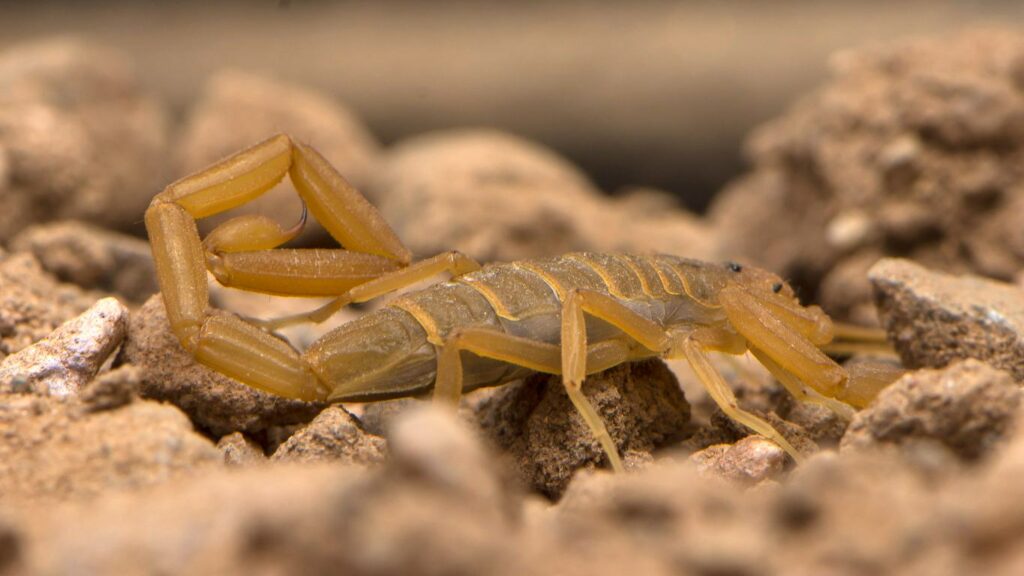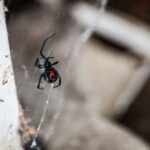With their ancient lineage and formidable appearance, scorpions often evoke a sense of mystery. Before we explore their winter habits, the team at Burns Pest Elimination delves into the basics to understand how to identify these arachnids and gain insights into their behaviors.
Identifying Scorpions: Appearance and Behavior
Scorpions are members of the arachnid family and boast distinctive features that reflect their aggressive lifestyles. They have eight legs and a segmented tail ending in a venomous stinger that they use for hunting and defense. Large, lobster-like pincers are located near their head, which they use for close-range attacks and grabbing their prey.
Scorpions can be found all across Arizona and the American south. They’re a common sight in garages, attics, closets, and bathtubs. They don’t typically pick fights with humans, preferring to remain safe and out of sight. However, they’ll defend themselves and their young with ferocity, so your best bet is to stay away from them.
Identifying the Most Threatening Species of Scorpion

While most scorpion species pose minimal threats to humans, certain varieties, such as the bark scorpion, wield potent venom. Even within a single species, the level of danger a scorpion poses is largely dependent on their size and age.
These pests come in various sizes, with some measuring only a few inches and others reaching lengths of several inches. The correlation between size and risk is intricate—smaller scorpions may possess proportionately more potent venom, making their stings impactful, while larger scorpions can inject more venom due to their size.
While it’s essential to consider size and species when evaluating the potential threat posed by a scorpion, it’s not a foolproof system. Certain species are more aggressive than others, and allergies to scorpion venom can exacerbate its effects. Caution should always come first.
Winter Survival: Diapause vs. Hibernation
So where do scorpions go in the winter? Contrary to the misconception that scorpions die off in the cold winter weather, these resilient creatures enter a state called “diapause,” a low-activity mode or rest akin to hibernation.
Diapause serves as a mechanism for scorpions to conserve energy during cooler weather. This state of paused development allows them to withstand the environmental challenges brought on by the cold. It’s a strategic adaptation that showcases the remarkable resilience of these hardy pests and a stark reminder that they’re a year-round nuisance.
Why Do Scorpions Enter Diapause?

Scorpions, being coldblooded, depend on their environment for body heat. This means they can easily remain active during the summer but become slumped and sluggish in the winter. As temperatures drop, they experience a physiological slowdown and enter diapause to conserve energy. This adaptation enables them to navigate winter without the need for constant movement and with longer stretches between meals.
Where Do Scorpions Go in the Winter?
As winter settles in, a common belief might be that scorpions retreat to some hidden corner of the wild, awaiting warmer days. However, the reality is quite different. Cold weather often draws scorpions into Arizona homes. Their search for warmth and shelter leads these resilient arachnids to seek refuge in the cozy nooks and crannies of houses. Garages, closets, and other indoor spaces become their winter hideouts, surprising homeowners who may not expect scorpions to be active during the colder months.
What Can I Do To Prevent Scorpions From Invading My Home This Winter?
The key to preventing scorpions from invading your home lies in exclusion. Seal any entry points that could serve as a gateway for scorpions. Walls, pipes, windows, and doors are potential access points that need careful attention. If sunlight can penetrate a gap, it’s large enough for a scorpion to exploit.
Beyond sealing entry points, maintaining a clutter-free environment reduces potential hiding spots for scorpions. Regularly decluttering attics, closets, and other storage spaces eliminates inviting environments for these arachnids. Outdoor debris and overgrown vegetation should be managed to minimize potential habitats. This comprehensive approach to scorpion prevention not only addresses current concerns but also establishes a foundation for year-round protection.
Burns Pest Elimination’s Year-Round Treatments
While prevention measures give you an edge against scorpions invading your home, having a trusted partner adds an extra layer of assurance. Burns Pest Elimination, with our expertise in pest management, stands as your go-to partner in year-round scorpion control. Our tailored solutions encompass inspection, prevention, and intervention strategies specifically designed to keep scorpions at bay no matter the season.
As winter approaches, let Burns Pest Elimination help you keep your home pest-free so you can maintain your cozy environment all yearlong.




